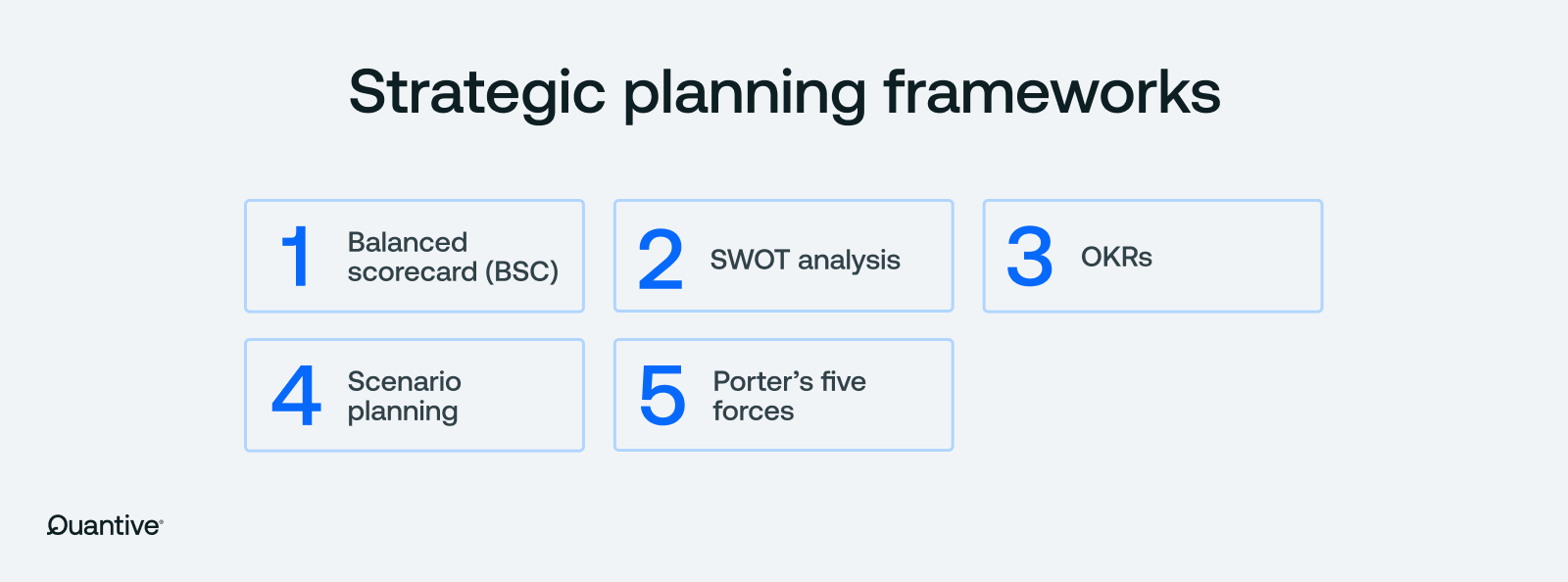

See how Quantive can help you achieve more of your strategy.
See how Quantive can help you achieve more of your strategy.
Playing chess without a strong opening is a guaranteed way to disadvantage yourself. Just like in chess, organizations without an adequate strategic planning process are unlikely to thrive and adapt long-term.
The strategic planning process is essential for aligning your organization on key priorities, goals, and initiatives, making it crucial for organizational success.
This article will empower you to craft and perfect your strategic planning process by exploring the following:
By the end of this article, you’ll have the knowledge needed to perfect the key elements of strategic planning. Ready? Let’s begin.
Strategic planning charts your business's course toward success. Using your organization’s vision, mission statement , and values — with internal and external information — each step of the strategic planning process helps you craft long-term objectives and attain your goals with strategic management .
The key elements of strategic planning includes a SWOT analysis, goal setting , stakeholder involvement, plus developing actionable strategies, approaches, and tactics aligned with primary objectives.
The following strategic planning components work together to create cohesive strategic plans for your business goals. Let’s take a close look at each of these:
Just as a chess player needs a gameplan to reach checkmate, a company needs a solid strategic plan to achieve its goals.
Without a strategic plan, your business will waste precious time, energy, and resources on endeavors that won’t get your company closer to where it needs to be.
Your ideal plan should cover all key strategic planning areas, while allowing you to stay present by measuring success and course-correcting or redefining the strategic direction when necessary. Ultimately, enabling your company to stay future-proof through the creation of an always-on strategy that reflects your company's mission and vision.
An always-on strategy involves continuous environmental scanning even after the strategic plan has been devised, ensuring readiness to adapt in response to quick, drastic changes in the environment.
Let’s dive deeper into the steps of the strategic planning process.
You understand the overall value of implementing a strategic planning process — now let’s put it in practice. Here's our 7-step approach to strategic planning that ensures everyone is on the same page:
The first step of the strategic planning process is understanding your organization’s core elements: vision, mission, and values. Clarifying these will align your strategic plan with your company’s definition of success. Once established, these are the foundation for the rest of the strategic planning process.
Questions to ask:

Once everyone on the same page about vision, mission, and values, it's time to scan your internal and external environment. This involves a long-term SWOT analysis, evaluating your organization’s strengths, weaknesses, opportunities, and threats.
Internal strengths and weaknesses help you understand where your organization excels and what it could improve. Strengths and weaknesses awareness helps make more informed decisions with your capabilities and resource allocation in mind.
Externally, opportunities and threats in the market help you understand the power of your industry’s customers, suppliers, and competitors. Additionally, consider how broader forces like technology, culture, politics, and regulation may impact your organization.
Questions to ask:
Prioritization puts the “strategic” in strategic planning process. Your organization’s mission, vision, values, and environmental scan serve as a lens to identify top priorities. Limiting priorities ensures your organization intentionally allocates resources.
These categories can help you rank your strategic priorities:
Questions to ask:
Next, you establish goals and metrics to reflect your strategic priorities. Purpose-driven, long-term, actionable strategic planning goals should flow down through the organization, with lower-level goals contributing to higher-level ones.
One approach that can help you set and measure your aligned goals is objectives and key results (OKRs). OKRs consist of objectives, qualitative statements of what you want to achieve, and key results, 3-5 supporting metrics that track progress toward your objective.
OKRs ensure alignment at every level of the organization, with tracking and accountability built into the framework to keep everyone engaged. With ambitious, intentional goals, OKRs can help you drive the strategic plan forward.
Questions to ask:
Get an in-depth look at OKRs with our Ultimate OKR Playbook

The next step of the strategic planning process gets down to the nitty-gritty “how” — developing a clear, practical strategic plan for bridging the gap between now and the future.
To do this, you’ll need to brainstorm short- and long-term approaches to achieving the goals you’ve set, answering a couple of key questions along the way. You must evaluate ideas based on factors like:
From your approaches, you can devise a detailed action plan, which covers things like:
With a detailed action plan like this, you can move from abstract goals to concrete steps, bringing you closer to achieving your strategic objectives.
Writing and communicating your strategic plan involves everyone, ensuring each team is on the same page. Here’s a clear, concise structure you can use to cover the most important strategic planning components:
Questions to ask:
Finally, it’s time to implement your strategic plan, making sure it's up to date, creating a persistent, always-on strategy that doesn't lag behind. As you get the ball rolling, keep a close eye on your timelines, milestones, and performance targets, and whether these align with your internal and external environment.
Internally, indicators like completions, issues, and delays provide visibility into your process. If any bottlenecks, inefficiencies, or misalignment arises, take corrective action promptly — adjust the plan, reallocate resources, or provide additional training to employees.
Externally, you should monitor changes such as customer preferences, competitive pressures, economic shifts , and regulatory changes. These impact the success of your strategic action plan and may require tweaks along the way.
Remember, implementing a strategic plan isn’t a one-time task — continual strategic evaluations are essential for an Always-On Strategy. It involves extending beyond planning stages and contextualizing the strategy in real-time, allowing for swift adaptations to changing circumstances to ensure your plan remains relevant.
Questions to ask:
You can use several frameworks to guide you through the strategic planning process. Some of the most influential ones include:

While strategic planning provides a roadmap for business success, it's not immune to challenges. Recognizing and addressing these is crucial for effective strategy implementation. Let's explore common issues encountered in strategic planning and strategies to overcome them.
Want a quick recap? Watch our summary below
Traditional strategic planning models often follow a linear, annual, and inflexible process that doesn't accommodate quick changes in the business landscape. Strategies formulated this way may quickly become outdated in today's fast-paced environment.
To overcome the rigidity of traditional strategic planning, your organization should integrate continuous environmental scanning processes. This includes monitoring market changes, competitor actions, and technological advancements, ensuring real-time insights inform strategic decision-making. Additionally, adopting agile methodologies allows for iterative planning, breaking down strategies into smaller, manageable components reviewed and adjusted regularly, ensuring adaptability in today's fast-paced landscape.
There's often a significant gap between the strategic objectives and their actual implementation, leading to misalignment, confusion, and inefficiency within the organization.
To bridge the gap, ensure accountability, alignment, and feedback-driven processes across the business. Linking team roles and responsibilities to lower-level objectives can fosters alignment and accountability, whereas aligning these with overarching strategic objectives ensure coherence in execution. To ensure goals are optimized on an ongoing basis, implement a feedback mechanism that continuously evaluates progress against goals, enabling regular adjustments based on market feedback and internal insights.
Traditional planning models rely on historical data and periodic reviews, which might not capture real-time changes or emerging trends accurately. This can result in misaligned strategies unsuitable for the current business landscape.
Leverage advanced analytics tools and AI-driven technologies. Invest in technologies that offer real-time tracking and reporting of key performance indicators, with dashboards and monitoring systems that provide up-to-date insights. These allow you to gather, process, and interpret real-time data for proactive decision-making that aligns with the current business landscape.
The absence of a feedback loop between strategy formulation, execution, and evaluation can impact learning and improvement. Companies might therefore struggle to refine their strategies based on real-time performance insights.
Establish a structured feedback loop encompassing strategy formulation, execution, and evaluation stages. Encourage employees to actively contribute insights on strategy execution, fostering a culture of continuous improvement and adaptation.
Navigating strategic planning goes beyond overcoming challenges. A successful strategic plan requires you to embrace a set of guiding best practices, helping you navigate the development and implementation of your strategic planning process.
With ever-changing business environments, a one-and-done approach to strategic planning is insufficient. Your strategic plan needs to be adaptable to ensure its relevancy and its ability to weather the effects of changing circumstances.
By including voices from across the organization, you can account for varying thoughts, perspectives, and experiences at each step of the strategic planning process, ensuring cross-functional alignment .
Continuous documentation of the strategic management process is crucial in capturing and communicating the key elements of strategic planning. This keeps everyone on the same page and your strategic plan up-to-date and relevant.
Root your decisions in evidence and facts rather than assumptions or opinions. This cultivates accurate insights, improves prioritization, and reduces biased (flawed) decisions.
Your strategic plan can only be successful if everyone is on board with it — company culture supports what you’re trying to achieve. Behaviors, rules, and attitudes optimize the execution of your strategic plan.
Using AI in strategic planning supports the development of an always-on strategy — amplifying strategic agility, conducting comprehensive environmental scans, and expediting planning phases. It can streamline operations, facilitate data-driven decision-making, and provide transparent insights into progress to drive accountability, engagement, and alignment with the strategic plan.
Careful strategy mapping is crucial for any organization looking to achieve its long-term goals while staying true to its mission, vision, and values. The seven steps in the strategic planning process outlined in this article provide a solid framework your organization can follow — from clarifying your organization’s purpose and developing a strategic plan, to implementing, monitoring, and revising performance. These steps will help your company meet goal measurements and create an always-on strategy that's rooted in the present.
It’s important to remember that strategic planning is not a one-time event. To stay effective and relevant, you must continuously monitor and adapt your strategy in response to changing circumstances. This ongoing process of improvement keeps your organization competitive and demonstrates your commitment to achieving your goals.
Quantive empowers modern organizations to turn their ambitions into reality through strategic agility. It's where strategy, teams, and data come together to drive effective decision-making, streamline execution, and maximize performance.
As your company navigates today’s competitive landscape, you need an Always-On Strategy to continuously bridge the gap between current and desired business outcomes. Quantive brings together the technology, expertise, and passion to transform your strategy and playbooks from a static formulation to a feedback-driven engine for growth.